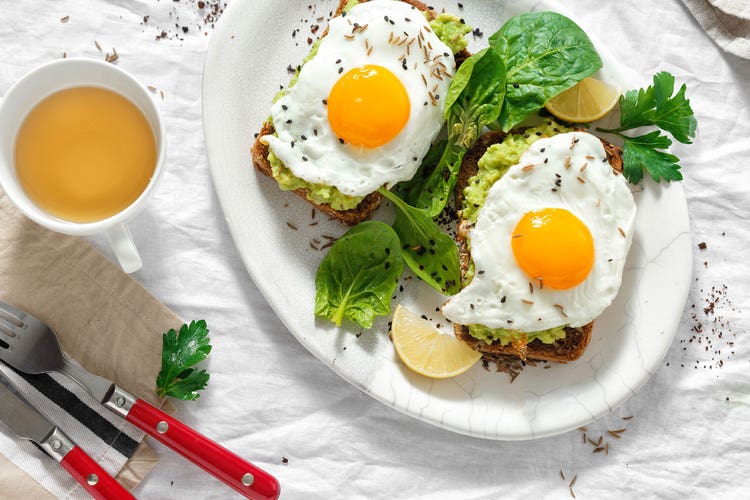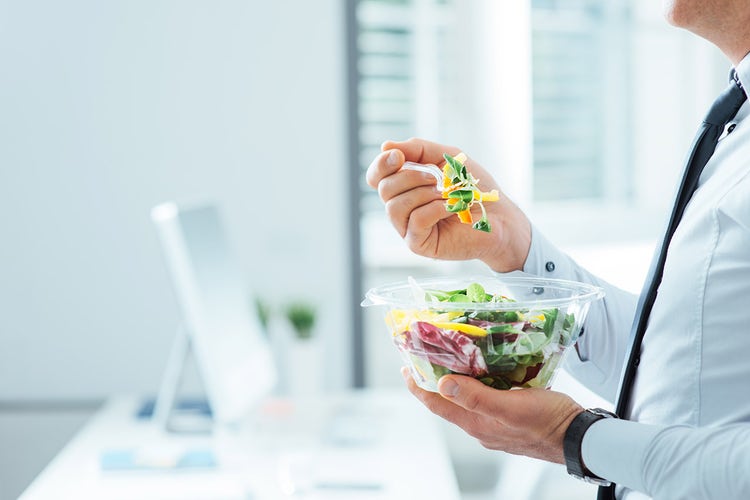Take a Break From These Food Rules

When eating to get fit, you’ll often find that you’re doing everything but, well … eating. Instead, it seems to be all about crunching calorie numbers or debating what you can’t have at mealtime, or worst of all, waiting for hours to pass until you can scarf down a morsel.
If you’re sick of the typical rules that define a diet, you’ve come to the right place. The following guide is designed to help you replace restrictions with a more nuanced approach to goal-based nutrition. Ready to enjoy eating again?
Give it a rest: Portion controlTry: Mindful eating

Either using eyeball cues or measuring your food out, you may control your food consumption with portion management. But that can take a lot of work and mental gymnastics. (Is that piece of cheese the size of the tip of my thumb?) Instead, how about you just eat? And we do mean just eat.
“Put down your phone and turn off the TV and any access to social media while you are eating,” says DeJarra K. Sims, ND, assistant professor of naturopathic medicine at Bastyr University in San Diego and author of “Your Healthiest Life Now” (Inkwell Productions, 2015). Then try asking yourself the following as you take each bite, she says:
- What colors do I see?
- What does the food feel like in my mouth or in my hand?
- What does this food smell like?
- Does it taste sweet, bitter, sour or salty?
- What sounds do I hear as I bite or chew?
“When people are aware of what they are feeling and intentionally focusing on the thoughts, emotions and sensations of their body at any given moment, they have a heightened sense of self-awareness,” Sims says. “This self-awareness is what helps them to halt or redirect themselves before participating in any unhealthy activity.”
And if you’re worried that your lack of portion control will send your diet out of control, consider these findings from an Australian study that compared the effect of portion control and mindfulness education on eating behaviors: Those who learned about mindful eating tended to eat less than the subjects who were educated about portion control, though not significantly. Another study published in Appetite found that mindfulness will help reduce unhealthy food choices but that it will not necessarily help you adhere to portion control.
So while mindfulness may not keep your portions completely under control, it will help you eat until you’re satisfied. At some point, they should balance out.
Give it a rest: Meal timingTry: Eating only when hungry

Have you decided to try one of the many versions of intermittent fasting? Maybe it’s time to stop watching the clock and start just going with the flow—specifically with the sound waves coming from your stomach.
You may have discovered through your meal-timing ways a renewed sense of your hunger cues. If not, the first thing you should understand is this: We are hungry when our body needs energy and we haven’t given it what it needs. But sometimes other emotions, like boredom, get in the way. The key is to silence the other digestive distractions and pay attention to the watery mouth, the rumbling tummy and the fluctuations in mood (Are you familiar with the term “hangry”?)—all signals your body makes when it wants food.
If you’re not sure what your hunger signals fill like, consider rating your hunger and satiety each time before and after you eat. Consider using a scale, where 0 is starving and a 10 is so full you’re sick. Like this:
0—Starving
1—Ravenous
2—Very Hungry
3—Moderately Hungry
4—Lightly Hungry
5—Neither Hungry nor Satiety
6—Lightly Full
7—Moderately Full
8—Comfortably Full
9—Stuffed
10—Sick
According to a study published in the journal Nutrients, taking the time to rate your hunger before you eat and then training yourself to only eat when hungry could help you lose weight and stop emotional eating. In this New Zealand study, participants who completed 60 days of hunger training lost nearly 15 pounds more than subjects who did it for less days.
Give it a rest: JuicingTry: Eating your vegetables

Have you devoted your mornings to green juice and sang its praises for how it lets you consume so many nutrients? You and the other devotees have helped create a $3.4 billion industry—at least that was the number heading into 2017. The thing is that when you juice, there are a couple of things missing that could determine your satiety and, ultimately, whether you eat more or not.
The first is chewing. That action of masticating your food helps tell the brain and all the other organs that calories are coming and gives those neural processes the time to let your stomach and brain communicate. Sipping on juice doesn’t give your body time to send cues that you’re full (or not) so that you feel satiety, and not sick, afterward.
The second is fiber. Juicing pulverizes the fiber, breaking it down and, in most cases, expelling it completely—that’s all the pulp that gets discarded (or made into veggie burgers). So while juice gives your cells the water that they need, it doesn’t allow you to consume all that wonderful fiber and whatever other cellular goodness that is in these plants making up your juice.
So swap your morning juice for a salad or your midafternoon snack for carrot sticks or cherry tomatoes, and pay attention to how full you feel afterward.
Give it a rest: Your diet du jour (keto, Paleo, etc.)Try: Eating for pleasure

What if you decided you could eat whatever you wanted? No rules limiting sugar, gluten, meat, dairy, or anything else that you or diet book authors can think of. Imagine just eating the foods you enjoy. Maybe it’s time.
According to a study using a sample of Women’s Health Initiative cohort, women who were more satisfied with their diet were more likely to stick with it. Nonadherent women reported more difficulty resisting negative emotions and prior (read: high fat) food preferences and habits. They were also more concerned about negative comments from others, according to the report published in Psychosomatic Medicine.
Now that doesn’t mean you should go off the proverbial nutrition rails. And a small study published in The Journal of Clinical Endocrinology & Metabolism explains why. If you eat for pleasure but not for hunger, it may stimulate the reward signals in your brain—triggering you to want to eat more of the pleasurable food, even if your body didn’t need it. Also known as hedonic eating, this phenomenon is closely linked to an increased body mass index.
Video credit: EvgeniyShkolenko, iStock
Photo credit: Jovanovic, Stocksy; Paul, Adobe Stock; aridav, Adobe Stock; Gitta, Adobe Stock; Dash, Adobe Stock; realstock1, Adobe Stock; WavebreakmediaMicro, Adobe Stock